复合材料缠绕成型工艺共26页
- 格式:ppt
- 大小:3.23 MB
- 文档页数:26

复合材料缠绕与编织的工艺流程和注意事项下载温馨提示:该文档是我店铺精心编制而成,希望大家下载以后,能够帮助大家解决实际的问题。
文档下载后可定制随意修改,请根据实际需要进行相应的调整和使用,谢谢!并且,本店铺为大家提供各种各样类型的实用资料,如教育随笔、日记赏析、句子摘抄、古诗大全、经典美文、话题作文、工作总结、词语解析、文案摘录、其他资料等等,如想了解不同资料格式和写法,敬请关注!Download tips: This document is carefully compiled by theeditor. I hope that after you download them,they can help yousolve practical problems. The document can be customized andmodified after downloading,please adjust and use it according toactual needs, thank you!In addition, our shop provides you with various types ofpractical materials,such as educational essays, diaryappreciation,sentence excerpts,ancient poems,classic articles,topic composition,work summary,word parsing,copy excerpts,other materials and so on,want to know different data formats andwriting methods,please pay attention!一、复合材料缠绕工艺流程:1. 原材料准备:根据设计要求选择合适的树脂、增强纤维(如碳纤维、玻璃纤维等)、填料等原材料。

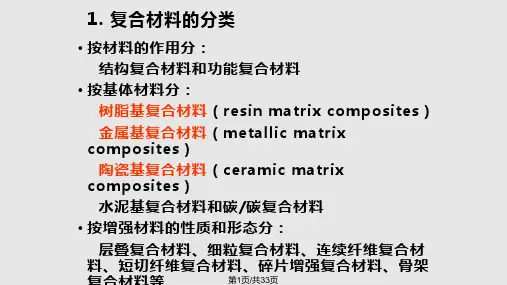
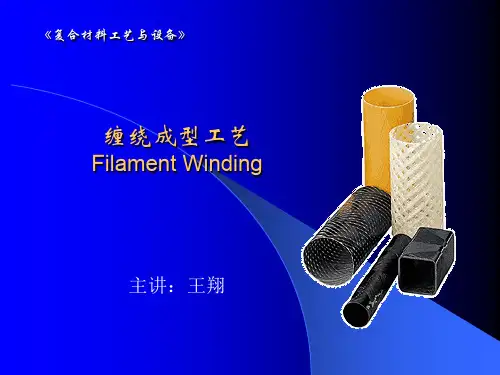

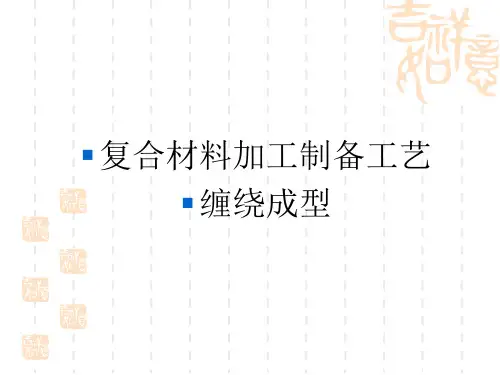
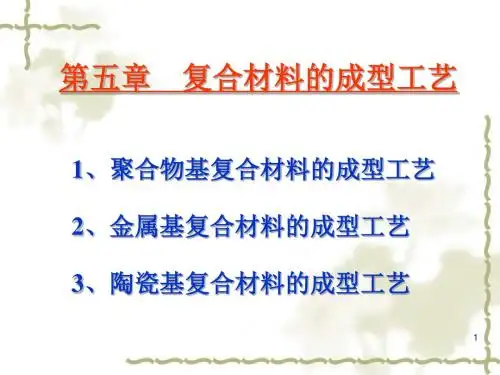
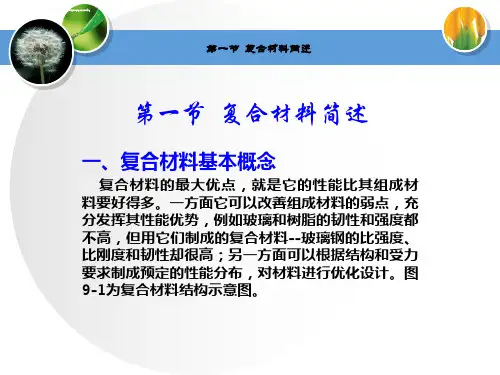
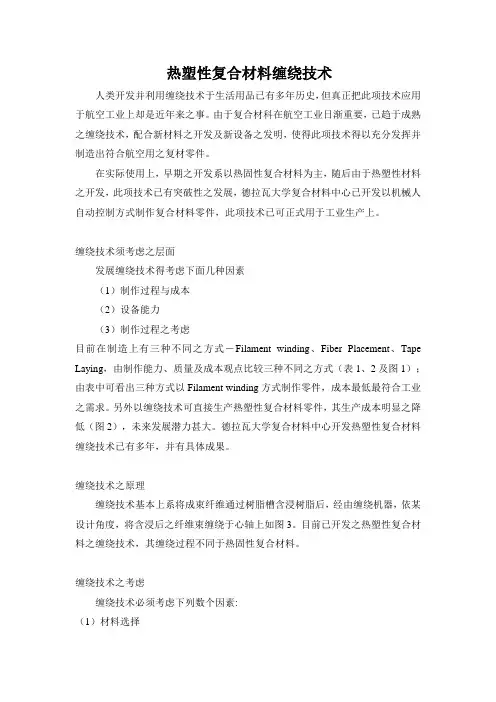
热塑性复合材料缠绕技术人类开发并利用缠绕技术于生活用品已有多年历史,但真正把此项技术应用于航空工业上却是近年来之事。
由于复合材科在航空工业日渐重要,已趋于成熟之缠绕技术,配合新材料之开发及新设备之发明,使得此项技术得以充分发挥并制造出符合航空用之复材零件。
在实际使用上,早期之开发系以热固性复合材料为主,随后由于热塑性材料之开发,此项技术已有突破性之发展,德拉瓦大学复合材料中心已开发以机械人自动控制方式制作复合材料零件,此项技术已可正式用于工业生产上。
缠绕技术须考虑之层面发展缠绕技术得考虑下面几种因素(1)制作过程与成本(2)设备能力(3)制作过程之考虑目前在制造上有三种不同之方式-Filament winding、Fiber Placement、Tape Laying,由制作能力、质量及成本观点比较三种不同之方式(表1、2及图1);由表中可看出三种方式以Filament winding方式制作零件,成本最低最符合工业之需求。
另外以缠绕技术可直接生产热塑性复合材料零件,其生产成本明显之降低(图2),未来发展潜力甚大。
德拉瓦大学复合材料中心开发热塑性复合材料缠绕技术已有多年,并有具体成果。
缠绕技术之原理缠绕技术基本上系将成束纤维通过树脂槽含浸树脂后,经由缠绕机器,依某设计角度,将含浸后之纤维束缠绕于心轴上如图3。
目前已开发之热塑性复合材料之缠绕技术,其缠绕过程不同于热固性复合材料。
缠绕技术之考虑缠绕技术必须考虑下列数个因素:(1)材料选择包括纤维、树脂种类湿式缠绕-热固性复材干式缠绕-热塑性复材(2)张力固定方式(3)材料喂入系统(4)心轴设计(5)加热系统(热塑性复合材料)缠绕机之选择缠绕技术发展多年并有多家机械公司开发二轴、三轴甚至多轴之缠绕机器,目前配合计算机系统而使功能多样化,较之传统机械式操作方式,更能将缠绕技术之优点发挥得淋漓尽致。
以下为三种不同型式之缠绕机之比较说明:(1)机械式缠绕机器a. 投资成本低b.制造速率高c.心轴几何形状受限(2)计算机控制缠绕机器a. 投资成本高b. 制造速率高c. 可缠绕复杂几何形状之心轴(3)机械人缠绕工作站(Robotic winding workcells)a. 投资成本中等b. 可缠绕复杂几何形状之心轴c. 赋予多种其它用途d. 最适于初期产品开发表1 质量比较Wet Filament Winding Prepreg Type HandLayupPrepreg Tow FiberPlacementVoid Content 4% to 8% < 1% 4% to 8%Thickness Flexibility 0.010 to 0.025inch / ply0.005 to 0.010inch / ply0.0005 to 0.0015inch / plyWinding AngleFlexibility>15 to 90 0 to 90 flat 0 to 90, variable Tow Cutand AddNO Hand Splice Only Programmable Laps and Gaps 0.125 inch 0.030 inch <0.030 inchGeometry Best for Bodies ofRevolutionCompound FlatPatternsCompound MachinePlacedMaterial Scrap Rate 20% to 40% 50% to 200% 5% to 20%From:Hercules Advanced Composites,1990图1 各种技术产品价格比较表2 成本/技术层面分析比较PROCESSFlat PanelNormalized Cost100 1000 10000units units unitsSingle CurvatureNormalized Cost100 1000 10000units units unitsCompound CurvatureNormalized Cost100 1000 10000units units unitsHand Layup 1.00 1.00 1.00 1.00 1.00 1.00 1.00 1.00 1.00TP FilamentWinding0.74 0.53 0.50 0.76 0.54 0.52 X X X AutomatedType LayerATL2.33 0.82 0.69 X X X X X XATLWith Press2.61 0.99 0.84 2.61 1.01 0.863.84 0.83 0.49From :M. Draper Labs, SAMPE Quaterly 1991图2 各种生产技术之产品件数与成本之关系图3 缠绕技术之原理图4 热塑性复材缠绕方式图5 热固性复合材料缠绕方式热塑性复材缠绕技术热塑性复材缠绕技术基本上沿袭热固性复材缠绕技术而来,所不同的为热固性缠绕技术发展较早,设备较完备,缠绕角度亦多样化,可直接以纤维含浸树脂并缠绕于模具上。
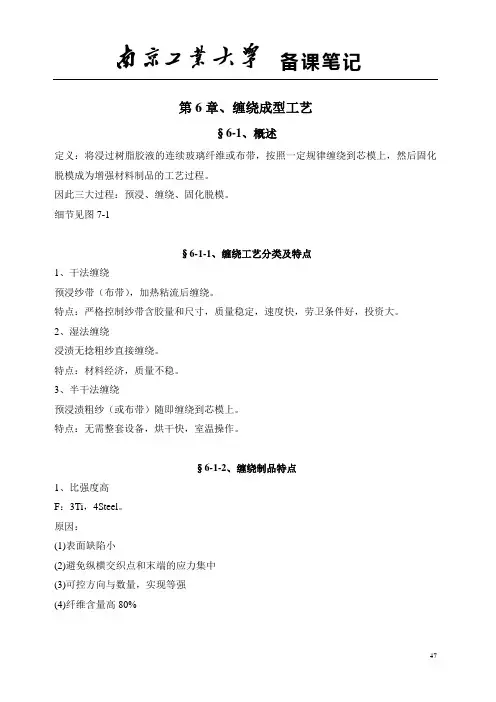
第6章、缠绕成型工艺§6-1、概述定义:将浸过树脂胶液的连续玻璃纤维或布带,按照一定规律缠绕到芯模上,然后固化脱模成为增强材料制品的工艺过程。
因此三大过程:预浸、缠绕、固化脱模。
细节见图7-1§6-1-1、缠绕工艺分类及特点1、干法缠绕预浸纱带(布带),加热粘流后缠绕。
特点:严格控制纱带含胶量和尺寸,质量稳定,速度快,劳卫条件好,投资大。
2、湿法缠绕浸渍无捻粗纱直接缠绕。
特点:材料经济,质量不稳。
3、半干法缠绕预浸渍粗纱(或布带)随即缠绕到芯模上。
特点:无需整套设备,烘干快,室温操作。
§6-1-2、缠绕制品特点1、比强度高F:3Ti,4Steel。
原因:(1)表面缺陷小(2)避免纵横交织点和末端的应力集中(3)可控方向与数量,实现等强(4)纤维含量高80%2、可靠性高克服材料的韧性不够及缺口带来的可靠性降低。
3、生产率高机械化,大批量。
4、成本低无捻减少了纺织等其它工费。
缺点:形状限制,投资大,必须大批量。
§6-1-3、原材料纤维增强材料,树脂基体选择原则:满足设计性能指标,工艺性参数及经济性要求。
1、增强材料玻纤(无碱,中碱无捻粗纱,高强纤维),碳纤维,芳纶纤维等。
纤维要求:(1)高档产品:碳纤维,芳纶纤维(2)制品性能要求(3)表面处理(4)与树脂浸渍性好(5)各股张力均匀(6)成带性好2、树脂基体指合成树脂与各种助剂组成的基体体系。
选用要求:(1)工艺性好,粘度与适用期最重要,适用量>4小时,η=0.35~1Pa·S。
(2)树脂基体的断裂伸长率与增强材料相匹配,方能获得满意效果。
(3)固化收缩率低和毒性刺激小(4)来源广、价格低§6-1-4、应用航天、导弹、军用飞机、水下装置,高强度、质量轻的高压容器,壳体。
民用管道,贮罐,质轻,耐腐,费低。
形成缠绕工艺的两部分——空间技术及民用部分。
§6-2、缠绕规律§6-2-1、缠绕规律的内容由导丝头(绕丝嘴)和芯模的相对运动实现。

复合材料缠绕成型工艺流程英文回答:Composite materials winding molding process involves the use of continuous fibers, such as carbon fiber or glass fiber, which are impregnated with resin and wound onto a mandrel or mold in a specific pattern. This process allows for the creation of complex shapes and structures with high strength-to-weight ratios.The first step in the winding molding process is the preparation of the mandrel or mold. This involves cleaning and coating the surface to ensure proper adhesion of the composite material. The mandrel or mold is then mounted onto a winding machine.Next, the continuous fibers are impregnated with resin. This can be done using various methods, such as resin infusion or prepreg. Resin infusion involves placing dry fibers onto the mandrel or mold and then infusing them withliquid resin. Prepreg, on the other hand, involves pre-impregnating the fibers with resin before they are wound onto the mandrel or mold.Once the fibers are impregnated with resin, they are wound onto the mandrel or mold. This is typically done using a computer-controlled winding machine, which ensures precise placement and tension of the fibers. The fibers are wound in a specific pattern, such as helical or hoop winding, to achieve the desired strength and shape of the final product.After the winding process is complete, the composite material is cured. This involves subjecting the material to heat and pressure, which activates the resin and allows it to harden. The curing process can take several hours or even days, depending on the specific resin system used.Once the composite material is cured, it is removed from the mandrel or mold. This can be done by either releasing the mandrel or mold from the material, or by removing the material from the mandrel or mold. The finalproduct is then trimmed and finished to the desired specifications.In conclusion, the winding molding process for composite materials involves the preparation of the mandrel or mold, impregnation of the fibers with resin, winding of the fibers onto the mandrel or mold, curing of the composite material, and removal of the final product from the mandrel or mold. This process allows for the creation of complex shapes and structures with high strength-to-weight ratios.中文回答:复合材料缠绕成型工艺流程涉及使用连续纤维(如碳纤维或玻璃纤维)浸渍树脂,并按照特定的模式缠绕到芯轴或模具上。
复材缠绕工艺
复材缠绕工艺是一种将多层复合材料缠绕在一起的工艺,在
飞机制造领域中得到广泛应用。
复材缠绕工艺的主要特点是将多层复合材料通过缠绕的方式,依次缠绕在一起。
它是目前国内外先进复合材料制造工艺中一种
常用的方法,可制造出强度高、重量轻、耐疲劳、耐腐蚀、耐高
温等性能优异的飞机结构件,广泛应用于航空航天和汽车工业等
领域。
在复材缠绕过程中,通常会利用树脂作为介质,以达到良
好的粘接效果。
同时,在复合材料结构设计时,通常会采用“内
应力”设计原则来避免复合材料与其他材料的应力集中。
“内应力”设计是指在复合材料结构设计过程中,要充分考虑到复合材
料所受应力可能超出其强度极限时产生的破坏形式。
它包括三个
方面:首先是由结构材料本身所存在的固有缺陷所引起的应力;
其次是由于复合材料在成型过程中,纤维取向不均匀所引起的应力;最后是由复合材料在固化成型时,受到外力作用所引起的应力。
复材缠绕工艺按其制造材料可分为:金属复材缠绕工艺、碳
纤维复材缠绕工艺等。
—— 1 —1 —。